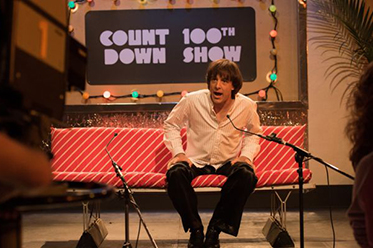 Ian “Molly” Meldrum is undeniably one of the great icons of Australian popular culture, one of the most recognisable figures in our television and music cultures.
Ian “Molly” Meldrum is undeniably one of the great icons of Australian popular culture, one of the most recognisable figures in our television and music cultures.
The unique place he holds in the hearts of Australians was demonstrated clearly in the outpouring of affection and concern following his life-threatening fall in 2011 (and his more recent fall in Thailand). So it is not surprising that following on the heels of their successful INXS mini-series last year, Channel 7 has chosen Molly as the subject of another music-based series, starting this Sunday.
Before it airs, it is worth pausing to consider how series such as this construct a version of the past, how this influences collective memory, and how they offer opportunities to challenge or reinforce social orthodoxies.
Entertainment based on events from the past is, clearly, not the same as history. Real life rarely translates exactly into a mini-series or movie, and needs lots of editing to fit into the beginning-middle-end, journey-undertaken narrative form that audiences are used to.
And while audiences are well aware that what they are watching is not “real”, for those with little knowledge of the events being portrayed they can be taken as truth. Inevitably some events are emphasised and others left out, reinforcing for those watching what – and whose – stories are important to tell.
So whose, and what, stories will we be seeing in Molly? One possible answer might be found by looking at the soundtrack to the series. These types of fictionalised histories can have specific effects on how we remember and think about music – a factor that is especially relevant in this case. Particular types of music can come to be seen as emblematic of particular time periods because of the way they are used in movies and television.
One example is the way the Vietnam war and rock and protest artists such as Hendrix and the Doors have become so closely associated, partly through the use of this music in films such as Apocalypse Now (1979) and Good Morning Vietnam (1987), and series such as Tour of Duty (1987-1990). That’s despite the actual music soldiers listened to being far more diverse.
So the soundtracks to series and films can become the de facto soundtrack to the past in collective memories, and can influence canon formation. Given that we know that one of the things that the popular music– and particularly rock – canon tends to do is exclude women and people of colour, the music used in a series such as Molly provides an opportunity to either reinforce or counteract that trend.
The soundtrack to the Molly series is expansive – 60 tracks over three CDs, the last of which is touted as curated by Meldrum himself. But a run-down of the 60 tracks listed on the soundtrack albums reveals a list overwhelmingly dominated by white males. Blondie, the Divinyls, Lynne Redrum and Suzi Quatro are the only women who feature on the first two discs (although Madonna is also featured in the trailer to the show), and KC and the Sunshine Band the only band with people of colour.
Important Australian acts such as Marcia Hines and Renee Geyer are obvious in their absence – there are three female Australian artists across the three discs. If these disks accurately represent the music that is played in Molly, then there is a question to be raised about the extent to which only white men will be presented as important to popular music in Australia.
The disk curated by Meldrum, however, is somewhat different. It alone has seven songs by female artists or by bands with women members, as well as another Sunshine Band track (people of colour undeniably do not do well on this compilation). In addition to this, Meldrum’s disc is, well, pretty queer.
It includes openly gay acts such as the Pet Shop Boys and Elton John, as well as queer artists such as Culture Club. The contrast in this respect between the first two discs and the third is marked, raising questions about what type of story Meldrum himself might be wanting to tell, as opposed to those making music decisions for Molly.
Countdown (1974-1987) was groundbreaking in the way it presented different versions of masculinity and femininity to a mainstream audience, so these types of artists definitely deserve a place here. And this leads to an aspect of the mini-series that will be particularly fascinating to see play out. How will aspects of Meldrum’s life such as his open bisexuality, and the rumoured hedonism of the Countdown experience, be presented?
At the height of Countdown’s popularity it was still highly unusual to see depictions of anything other than heterosexuality on television – especially in the early evening time slot Countdown occupied. Meldrum’s bisexuality was, for a long time, known but not known, becoming gradually more talked about as attitudes have changed.
If the series can foreground Meldrum’s queerness in the nation’s collective memory as an important part of the identity of this icon, even as it highlights the “Aussie larrikin” nature of his persona (which the trailers seem to do) then it has the potential to disrupt certain conventional ideas about what constitutes masculinity in this country.
I know I won’t be the only person watching with great interest on Sunday to see what version of Molly will be on show. The first episode of Molly will air on Channel 7 on Sunday 7 February 2016.
How will ‘Molly’ help us remember Australian culture?
Catherine Strong, Lecturer, Music Industry, RMIT University
This article was originally published on The Conversation. Read the original article.
Image: Samuel Johnson as Ian “Molly” Meldrum in Molly – courtesy of Channel 7
